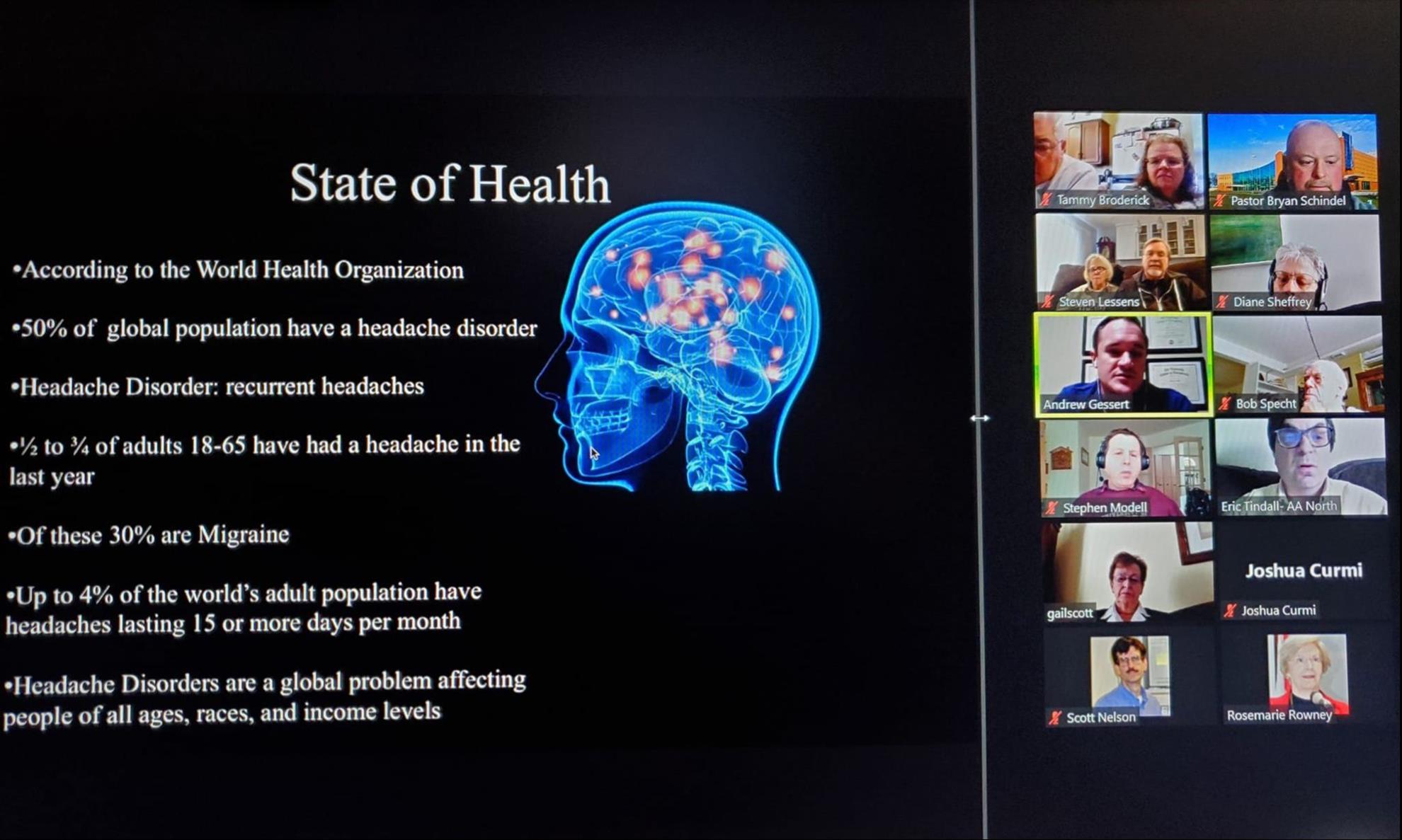At The Rotary Club of Ann Arbor North Zoom Lunch Meeting Andrew Gessert was our speaker talking about headaches on January 27, 2022.
Andrew said according to the World Health Organization:
- 50% of the global population have a headache disorder.
- Headache disorders: recurrent headaches.
- 1/2 to 3/4 of adults 18-65have had a headache in the last year.
- of those 30% are migraine.
- Up to 4% of the worlds population have headaches lasting more days per week.
- Headache disorders are a global problem affecting people of all ages, races, and income levels.
The most common types of headaches are: 150 different types of headaches.
Migraine
- Begins in teenage years but mostly affect 35-45.
- Most common in women 2:1.
- Described as severe, one sided, pulsating/pounding pain.
- May switch sides.
- Triggers: Food, drinks, stress, bright light, smells, physical exertion, changes in environment, medication, hormones.
- Aura or visual disturbance: Colored or flashing light, blind spots, wavy lines, NT in face, arm and leg.
Tension
- Most common headache disorder.
- May present similar to migraine.
- Episodic: occurring less then 15 days/month
- Chronic: occurring more then 15 days/month, 1 of 3% of adults.
- Begins in teenage years, 3:2 ratio of women to men.
- Triggered by stress, fatigue, poor nutrition, neck pain, TMJ dysfunction.
- Can spread into the neck or come from the neck.
- Episodic attacks last a few hours.
- Described as bilateral pressure/tightness, band like pain around the head.
Cervicogenic
- Originates in the neck at different segmental levels
- May involve the nerve roots, discs, or facet joints.
- Unilateral pain that travels from the neck over the top of the head to the eye.
- Presents as episodic then progresses to chronic.
- May be aggravated with neck movement.
- Rare cases involve nausea, vomiting, dizziness, sensitivity to sound or light, and blurred vision.
Medication-overuse (rebound)
- Caused by chronic or excessive use of medication to treat headaches.
- Most common secondary headache disorder.
- Occur in patients who have a pre-existing headache disorder and overused 1 or more treatment drugs.
- More then 10 days a week.
- An episodic headache becomes chronic.
- Affects up to 5% of some populations, women more then men
- Persistent and worsen on awakening.
- Occurs almost daily and improves transiently with analgesics and returns when meds wear off.
- May have nausea, anxiety, irritability, asthenia, restlessness, difficulty concentrating.
- Treat by removing the drug.
- May require hospitalization for controlled treatment.
Cluster
- Series of short but extremely painful headaches every day for weeks or months.
- Located in or around one eye with tearing, redness, runny nose, or congestion on affected side.
- May have a drooped eyelid.
- Episodic or chronic forms lasting 15 minutes to 3 hours 1-3 times per day.
- Burning or piercing pain, but may be throbbing or constant.
- Occur when the trigeminal nerve at the base of the brain is activated.
- The headaches are cyclical (alarm clock).
- Trigeminal nerve: relays heat, and pain sensitivity to face.
- Pain starts suddenly.
The common solution to headaches are:
- Medications: over the counter and Rx, used for preventing or treatment.
- Injections: trigger points, nerve blockers.
- Supplementing with herbs.
- Medication
- Hot or cold therapy.
- Acupuncture
- Vitamin therapy.
The underline causes of headaches are:
- There are many things that trigger a headache.
- Tumors
- Blow to the head.
- Hangover
- Stress or fatigue.
- Since most headaches utilize the same neural pain pathway it would make sense to explore this pathway and how it could be affected.
The natural solutions to headaches are:
- Drink more water.
- Get plenty of sleep.
- Eat something.
- Reduce stress.
- Supplement with Magnesium.
- Cut out Gluten.
- Peppermint and Lavender Essential Oils.
- Herbs: Feverfew and Butterbur.
Click Here for more photos of Andrew's presentation.
